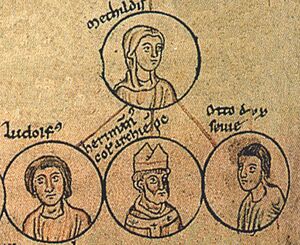Ezzo, Count Palatine of Lotharingia facts for kids
Quick facts for kids
Ezzo
|
|
|---|---|
| Count Palatine of Lotharingia | |
| Born | c. 955 Lotharingia |
| Died | 21 March 1034 Saalfeld, Thuringia |
| Noble family | Ezzonen |
| Spouse(s) | Matilda of Germany |
| Issue | Liudolf of Lotharingia Otto II, Duke of Swabia Herman II (archbishop of Cologne) Theophanu, Abbess of Essen Richeza of Lotharingia |
| Father | Herman I, Count Palatine of Lotharingia |
| Mother | Heylwig of Dillingen |
Ezzo (born around 955 – died March 21, 1034) was a very important person in the Rhineland area during his time. He was a member of the Ezzonid family. From 1015 until his death, he held the title of Count Palatine of Lotharingia.
Ezzo was connected to powerful rulers. He was the brother-in-law of Emperor Otto III. His daughter, Richeza, became the Queen of Poland. These connections made him one of the most influential figures of his era.
Contents
Ezzo's Life Story
Early Years and Family Connections
Ezzo was the son of Herman I, a count in Lotharingia, and his wife Heylwig. When he was a child, Ezzo was sent to be educated by Bishop Ulrich of Augsburg. Bishop Ulrich was a relative of Ezzo's mother. We don't know much about Ezzo's childhood.
Ezzo married Matilda of Germany. She was the daughter of Emperor Otto II and Empress Theophanu. This marriage was very important for Ezzo. Empress Theophanu agreed to the marriage. She likely wanted to gain the support of Ezzo's powerful family for the throne.
Matilda received land in Thuringia and Duchy of Franconia as her dowry (a gift of property from her family). Ezzo gave her his family estate, Brauweiler, near Cologne.
Becoming a Powerful Count
When Ezzo's father died in 996, Ezzo inherited a lot of land. He received areas like Cochem on the Mosel river and estates near Tomburg Castle. Around this time, he also became a Count Palatine. This meant he had special rights and power in certain regions. He was called a count in the Auelgau in 1015 and a Count Palatine in the Bonngau in 1020. He also gained control over the Ruhrgau area and became a protector of Essen Abbey.
Conflicts and Agreements with the Emperor
After Emperor Otto III died in 1002, Ezzo hoped to become the next emperor. However, Henry II was chosen instead. Ezzo and Henry II immediately had a difficult relationship. Henry II questioned Ezzo's right to some of his lands. Ezzo argued that these lands were his wife Matilda's inheritance from Otto III.
This disagreement lasted for many years. It became very serious in 1011. Henry II needed Ezzo's military help in Lotharingia. So, Henry II was forced to make peace with Ezzo. Ezzo's victory led to big changes in Henry II's policies. Henry II recognized Ezzo's right to his inherited lands. He also gave Ezzo more royal territories, including Kaiserswerth, Duisburg, and Saalfeld. In return, Ezzo gave up his claim to the throne.
Henry II also included Ezzo's family in his plans for the eastern parts of the empire. He helped arrange the marriage of Ezzo's daughter, Richeza, to Mieszko II Lambert, who was the heir to the Polish throne.
Founding Brauweiler Abbey
These large land gifts made Ezzo one of the most powerful princes in the Holy Roman Empire. His growing power and the respect for his family were shown when he founded Brauweiler Abbey. This abbey was built in the place where Ezzo and Matilda had celebrated their marriage. Construction began after they visited Rome in 1024.
The Benedictine monastery was officially opened in 1028. It was meant to be the burial place and spiritual center for Ezzo's family.
Later Life and Death
Henry II died in July 1024 without any children to inherit his throne. Conrad, a relative of Otto I, was chosen as the new King of the Romans. Ezzo supported Conrad. In November 1025, Ezzo invited the nobles of Lotharingia to Aachen. There, they showed their loyalty to the new king. Some nobles, like Pilgrim, the archbishop of Cologne, had not supported Conrad before.
Ezzo's wife, Matilda, died unexpectedly during a visit to Ezzo's brother. Ezzo was in Aachen at the time. She was buried at Brauweiler Abbey.
We don't know much about Ezzo's life after this. He died at a very old age in Saalfeld on March 21, 1034. He was buried in Brauweiler Abbey, as he had planned.
Ezzo's life and his official duties are described in a historical document called the Fundatio monasterii Brunwilarensis. He was very active in politics, especially when it helped his own interests or increased his family's power and land. He was skilled at getting favors from Empress Theophano, Emperor Otto III, and later Henry II. This shows his personal ambition and political cleverness.
Ezzo's Children
Ezzo and Matilda had many children:
- Liudolf (born around 1000 – died 1031), who was the Count of Zütphen.
- Otto II (died 1047), who became the Count Palatine of Lotharingia and later the Duke of Swabia.
- Herman II (995–1056), who became the Archbishop of Cologne.
- Theophanu (died 1058), who was an Abbess (head of a convent) at Essen and Gerresheim.
- Richeza (died 1063), who became the Queen of Poland after marrying King Mieszko II Lambert.
- Adelheid (died around 1030), who was an Abbess of Nivelles.
- Heilwig, who was an Abbess of Neuss.
- Mathilde, who was an Abbess of Dietkirchen and Vilich.
- Sophie, who was an Abbess of St. Maria in Mainz.
- Ida (died 1060), who was an Abbess of Cologne and Gandersheim Abbey.



